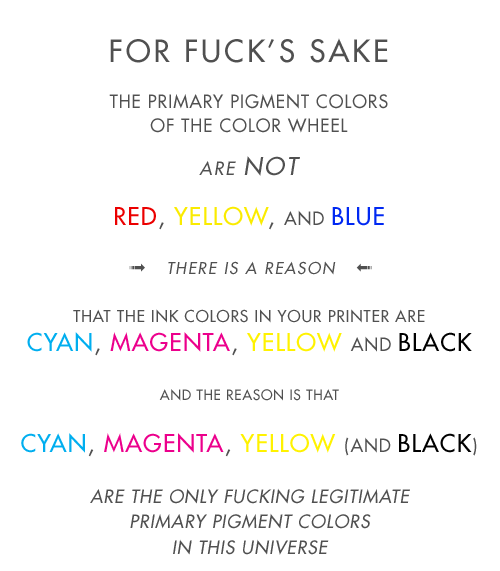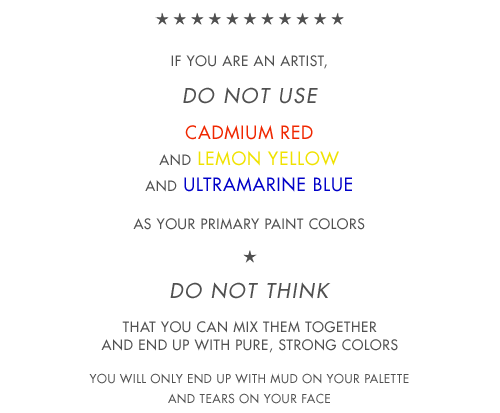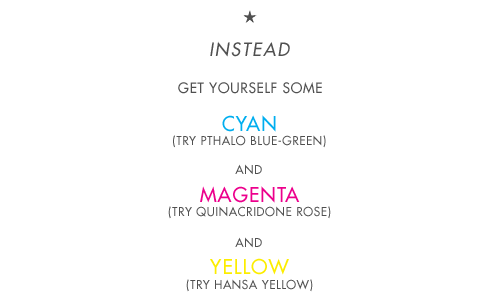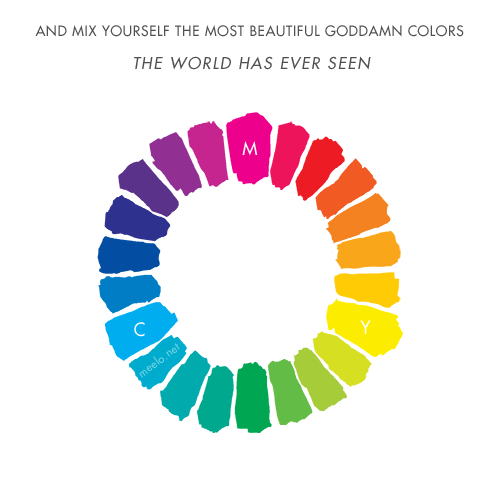the-ford-twin:the-ford-twin:the-ford-twin:the-ford-twin:noidea4goodname:kamiyu910:someoneintheshadow
the-ford-twin:the-ford-twin:the-ford-twin:the-ford-twin:noidea4goodname:kamiyu910:someoneintheshadow446:idoko:thatswhiskytoyou:luhbrazart:poppypicklesticks:lackyannie:meelo-dot-net:ask-dr-knockout:This.a public service announcementand i thought only bob ross knew what was upthis single post is more useful to me then four years of art school We did it in color study class on my college and it’s incredible the difference between using red/blue/yellow than cyan/magenta/yellow.The purple was colored like shit, so as the greens. Than we tried the actuall primary colors and it FELT SO GOOD!I JUST TESTED IT IN MY ART PROGRAM AND HOLY SHIT IT WORKED REALLY WELLOn the left we have dissapoinment; on the right, love.Then why do they teach us that RBY are primary colours in Pre-KG????To mess with our heads….Or because they think that cyan and magenta are too difficult for kids to learn? Lame either wayReshare to save livesOkay, no. No no no no no no no no NO.Listen up you fucks because I’m not wasting thousands of dollars on an art degree to watch y’all fuck up basic color theory.Red, yellow, and blue are the primary colorsIf you’re using p i g m e n t.Do you hear me? When you’re using traditional media, fucking actual goddamn paint, Bob Ross style, your primary colors are!When you use paint, your primary colors are red yellow and blue and don’t forget it.NOW THAT CHANGES COMPLETELY WHEN YOU GO FUCKING DIGITAL.THE DIGITAL PRIMARY COLORS ARE RED BLUE AND GREEN IF AND ONLY IF YOUR WORK IS GOING TO STAY DIGITAL, ON THE SCREEN, AND NEVER LEAVE THE SCREEN, AND OF COURSE IF YOUR WORK IS GOING TO BE PRINTED. ON A PRINTER. WITH INK. THEN. AND O N L Y T H E N.ARE YOUR PRIMARY COLORS.CYAN. MAGENTA.AND YELLOW.So say it with me folks!Red yellow and blue, are the primary colors for traditional pigment that’s mostly used in paints and shit. You use red yellow and blue when you’re painting traditionally, Bob Ross style. Red blue and green is light, which is what you’re painting with when you pick up your tablet and go digital.CMYK is ink, and ink only. You could use cyan, magenta, and yellow as your primary colors in paint if you wanted to be a complete dick, but they’re not your primary colors unless your work is going to be printed using. i n k. The only time they could be considered the primary colors in a traditional medium is if you’re using ink.Good day.Also thatswhiskytoyou’s color mixing is bullshit because THIS:Is my icon. I painted this using RED. GREEN. AND BLUE. AS MY PRIMARY COLORS and they turned out fine. Of course, I used the finger smudge tool first and then the color mixing tool and then the blur tool, but hey what do I know.Clearly using the blur tool only doesn’t cut it.“Oh but Leo!” You say. “You used cyan and magenta in that color wheel!”Well bitch guess what.this is the digital color wheel. I’d say I mimicked that pretty well, don’t you think?Oh and one other thing, notice how Blue and Yellow are directly opposite each other on this color wheel? That’s because we’re dealing with light, and with light, yellow and blue are complimentary colors.Which is why when you mix them, it looks like this:Which is a pretty neutral gray tone: They cancel each other out on the rgb color wheel when you mix them together.BUT WITH PIGMENT THE PLACEMENT IS DIFFERENTIf you’ll notice, yellow and violet are now opposite each other, meaning they’re complimentary colors and if you mix them, they’ll make a neutral gray.But if you mix yellow and blue, same colors as before, YOU GET THIS:Now keep in mind that the person in the video uses a darker blue, so they get a darker green, but the point is that it doesn’t make that neutral gray.Now what happens when we mix yellow and violet paint?Ah yes, you get a bunch of muted colors the more evenly you mix them.What happens when you mix yellow light and purple light?I see, I see.OH AND ONE MORE THING.They didn’t teach you about red blue green and cmyk in pre-k because when most of us were in pre-k digital art was still in its early stages and what fucking seven year old knows how to use a printer.GUESS WHO’S NOT FUCKING DONE YET:The reason the primary colors for light are so dramatically different from the primary colors for paint and ink is because your eye only receives combinations of red light, blue light, and green light. Our eyes do not have a sensor (cone cell) for yellow light. So when we paint with light, red green and blue are our primary colors. Because of our eyes.Furthermore, paint primary colors are colors that cannot be created by mixing other colors together. For paint, they are red yellow and blue, because you cannot mix orange and green to get yellow. Mixing orange and purple paint does not make red. And mixing green and purple paint does not make blue.Mixing blue and green paints will make cyan. Mixing red and blue paints will make magenta.That’s why cyan and magenta aren’t primary paint colors.However, you can’t mix yellow and blue ink and get cyan. You can’t mix red and blue ink to get magenta.And that’s why cyan and magenta are the primary ink colors.Brighter and stronger paints are created through tints and shades, through a thorough understanding of color theory and a few quality paint recipes. Not by bullshit posts on tumblr designed to mislead you.This popped up in my feed, and I have to respond because, as the famous XKCD comic goes… Someone is wrong on the internet.When you are talking about mixing light, you are talking about additive color. That’s RGB, that’s how your computer screen works. Every pixel is actually three little lights, a red one, a green one, and a blue one. Turn them all off, you’ve got black, turn them all on, and it looks white. All the colors your screen can display are created by adjusting that mix.When you are talking about mixing dyes, inks, or paint, you are talking about subtractive color. That’s CMY. Pigments absorb certain light wavelengths and reflect others. When you mix paints, they absorb more light (subtract) and reflect less. So cyan paint is absorbing red light and reflecting blue and green. Yellow paint is absorbing blue light and reflecting red and green. Mix them, and you will get paint that absorbs red and blue light and only reflects green.Don’t believe me? James Gurney knows what’s up. He wrote the book on Color and Light.As for the RYB color model, I’ll just quote wikipedia here:“RYB predates modern scientific color theory, which has determined that magenta, yellow and cyan are the best set of three colorants to combine, for the widest range of high-chroma colors.”Basically the RYB color model is kind of like the flat Earth model. Yeah, people thought that was how things worked for a long time, and it kind of made sense if you didn’t observe things too closely, but we’ve got new information, man. New shit has come to light.I expect this person will have some kind of rebuttal that will involve swearing in all caps and posting silly gifs. They might even try to demonstrate how CMY works while working in a digital RGB color space again, which is just… *sigh*Anyway.If you are working digitally, you are dealing with additive color, and you are working with RGB light. Yes, of course you can get magenta by mixing red and blue and cyan by mixing green and blue because that is how your computer screen works.If you are working with paints or pigments, you’re dealing with subtractive color. It’s actually a lot more complex than simple CMY because there is a whole universe of materials that reflect and absorb light differently, which is why there are special paints for super bright colors and such, but the simple fact is that you can mix a lot more colors with CMY than with RYB. -- source link
Tumblr Blog : blog.meredithaldenlewis.com
#color theory



